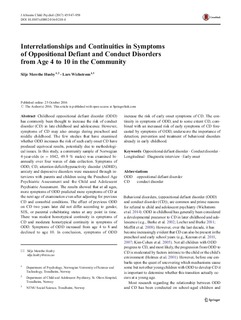| dc.contributor.author | Husby, Silje Merethe | |
| dc.contributor.author | Wichstrøm, Lars | |
| dc.date.accessioned | 2018-01-09T13:26:33Z | |
| dc.date.available | 2018-01-09T13:26:33Z | |
| dc.date.created | 2016-11-30T12:06:40Z | |
| dc.date.issued | 2016 | |
| dc.identifier.citation | Journal of Abnormal Child Psychology. 2017, 45 (5), 947-958. | nb_NO |
| dc.identifier.issn | 0091-0627 | |
| dc.identifier.uri | http://hdl.handle.net/11250/2476457 | |
| dc.description.abstract | Childhood oppositional defiant disorder (ODD) has commonly been thought to increase the risk of conduct disorder (CD) in late childhood and adolescence. However, symptoms of CD may also emerge during preschool and middle childhood. The few studies that have examined whether ODD increases the risk of such early onset CD have produced equivocal results, potentially due to methodological issues. In this study, a community sample of Norwegian 4-year-olds (n = 1042, 49.9 % males) was examined bi-annually over four waves of data collection. Symptoms of ODD, CD, attention-deficit/hyperactivity disorder (ADHD), anxiety and depressive disorders were measured through interviews with parents and children using the Preschool Age Psychiatric Assessment and the Child and Adolescent Psychiatric Assessment. The results showed that at all ages, more symptoms of ODD predicted more symptoms of CD at the next age of examination even after adjusting for previous CD and comorbid conditions. The effect of previous ODD on CD two years later did not differ according to gender, SES, or parental cohabitating status at any point in time. There was modest homotypical continuity in symptoms of CD and moderate homotypical continuity in symptoms of ODD. Symptoms of ODD increased from age 4 to 8 and declined to age 10. In conclusion, symptoms of ODD increase the risk of early onset symptoms of CD. The continuity in symptoms of ODD, and to some extent CD, combined with an increased risk of early symptoms of CD forecasted by symptoms of ODD, underscore the importance of detection, prevention and treatment of behavioral disorders already in early childhood. | nb_NO |
| dc.language.iso | eng | nb_NO |
| dc.publisher | Springer | nb_NO |
| dc.rights | Navngivelse 4.0 Internasjonal | * |
| dc.rights.uri | http://creativecommons.org/licenses/by/4.0/deed.no | * |
| dc.title | Interrelationships and continuities in symptoms of oppositional defiant and conduct disorders from age 4 to 10 in the community | nb_NO |
| dc.type | Journal article | nb_NO |
| dc.type | Peer reviewed | nb_NO |
| dc.description.version | publishedVersion | nb_NO |
| dc.source.pagenumber | 947–958 | nb_NO |
| dc.source.volume | 45 | nb_NO |
| dc.source.journal | Journal of Abnormal Child Psychology | nb_NO |
| dc.source.issue | 5 | nb_NO |
| dc.identifier.doi | 10.1007/s10802-016-0210-4 | |
| dc.identifier.cristin | 1406384 | |
| dc.relation.project | Norges forskningsråd: 228685 | nb_NO |
| dc.relation.project | Norges forskningsråd: 202478 | nb_NO |
| dc.description.localcode | © The Author(s) 2016. This article is published with open access at Springerlink.com. This article is distributed under the terms of the Creative Commons Attribution 4.0 International License (http://creativecommons.org/licenses/by/4.0/), which permits unrestricted use, distribution, and reproduction in any medium, provided you give appropriate credit to the original author(s) and the source, provide a link to the Creative Commons license, and indicate if changes were made. | nb_NO |
| cristin.unitcode | 194,67,40,0 | |
| cristin.unitname | Institutt for psykologi | |
| cristin.ispublished | true | |
| cristin.fulltext | original | |
| cristin.qualitycode | 2 | |

